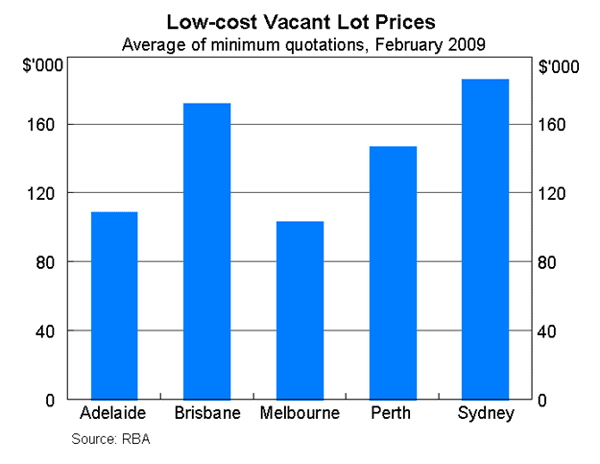A March 26, speech by Anthony Richards, head of the Economic Analysis Division of the Reserve Bank of Australia (RBA) brings home the extent to which land use regulations, under the guise of “urban consolidation” have increased the price of new starter houses in Australia.
Urban consolidation policies, which pervade the capital cities and other markets, place serious restrictions or prohibitions on developing urban fringe land for housing. Government planning departments decide what land can be developed and what land cannot be developed, with much more of it falling into the “prohibited” category than not. The result is to significantly ration land for housing, which naturally raises its price (the scarcity-price increase relationship is an “Economics 101” fundamental).
In noting a connection between high new housing costs Richards cites RBA research on the cost of low-priced “raw” land for house building on the fringes of the five largest capital cities. A 400 to 500 square metre block 30 to 40 kilometers from the central business district costs from approximately $100,000 in Melbourne and Adelaide to nearly $150,000 in Perth and between $160,000 and $190,000 in Sydney and Brisbane (Figure). This means that land on the urban fringe for housing development costs from $2,000,000 to nearly $4,000,000 per hectare. This is obviously well above the agricultural value that would be the starting point of negotiation if urban consolidation were not acting to create a scarcity of land in the nation with perhaps the smallest urban footprint in the world (only 0.3 per cent of the nation is in urban areas).
Advertisement

(Note: the figure above is taken from the Anthony Richards RBA speech)
These are exceedingly high prices. The Housing Industry Association has reported residential land price increases so severe between 1993 and 2006 that not even Typhoon Larry’s impact on fruit prices could compete (as measured by the Consumer Price Index for Sydney). Over the same period, house construction prices have risen only slightly ahead of inflation.
In the United Kingdom, government reports have documented virtually the same housing affordability destroying impacts of land use policies. There land on which development is permitted can command a price 500 times that of adjacent land on which development is not permitted.
Raw land is an important component of new house costs. Every dollar added to the price of raw land adds at least a dollar to the final price of the whole house and land package. If urban fringe land was not restricted by urban consolidation, it would be expected that it would command its agricultural value plus a premium.
It is likely that such land would sell for no more than $10,000 per hectare. Even if it cost twice this amount, it would make the raw land price per 500 square meter block little above $1,000 (before allowing for public infrastructure, especially streets) rather than the $100,000 to $190,000 per “low-cost” block indicated by the RBA.
Advertisement
Suffice to say that land use policies appear to be adding between $100,000 to $190,000 to the price of new starter housing on the fringe of capital cities. No conceivable first homebuyer grant could ever compensate for such excessive costs.
Of course, the problem is even worse than that, because urban consolidation has so strangled the supply of new housing, that little, if any new starter housing is being built on the urban fringe of any capital city.
Wisely, the Victorian government has begun to moderate its urban consolidation policies, raising hopes that new starter housing on the fringe of Melbourne will become more affordable in the years ahead. Hopefully other states follow this lead.
The high land prices reported by the RBA and the industry underscore the problem faced by young Australian households and the growing number of immigrants. The inexpensive starter housing on the urban fringe that fueled the home ownership expansion and contributed so much to household prosperity is simply no longer allowed because of urban consolidation policies.
Richards notes that “the ability to expand the supply” of housing will be an important factor in housing affordability and that “in the long run housing affordability will be mostly driven by the level of housing prices relative to household incomes”. Our Demographia Annual International Housing Affordability Survey (PDF 712KB) uses such an indicator (the Median Multiple).
Indeed, if urban consolidation policies had been in place immediately after World War II, it is likely that most households would continue to be renters and they would be considerably less affluent. The Sydney “six pack” apartment building might be the symbol of the nation’s housing rather than the house on a quarter acre block. Restoring realistic prices to urban fringe land will have much to do with whether or not the next generation lives as well as their parents.